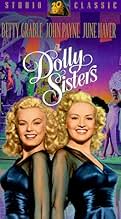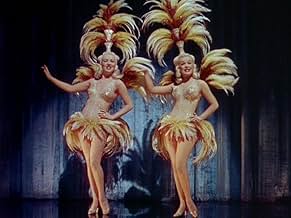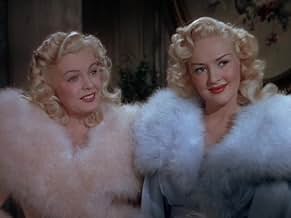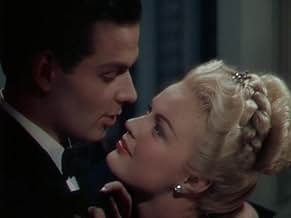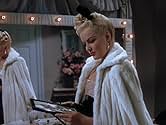IMDb-BEWERTUNG
6,2/10
883
IHRE BEWERTUNG
Füge eine Handlung in deiner Sprache hinzuTwo sisters from Hungary become famous entertainers in the early 1900s. Fictionalized biography with lots of songs.Two sisters from Hungary become famous entertainers in the early 1900s. Fictionalized biography with lots of songs.Two sisters from Hungary become famous entertainers in the early 1900s. Fictionalized biography with lots of songs.
- Regie
- Drehbuch
- Hauptbesetzung
- Für 1 Oscar nominiert
- 1 Nominierung insgesamt
Fred Aldrich
- Soldier
- (Nicht genannt)
Lester Allen
- Morrie Keno
- (Nicht genannt)
Herbert Ashley
- Fields
- (Nicht genannt)
Nino Bellini
- French Actor
- (Nicht genannt)
Brooks Benedict
- Party Guest
- (Nicht genannt)
Trude Berliner
- German Actress
- (Nicht genannt)
Edward Biby
- Party Guest
- (Nicht genannt)
Lulu Mae Bohrman
- Party Guest
- (Nicht genannt)
Eddie Borden
- Man on Bus
- (Nicht genannt)
Empfohlene Bewertungen
One of Betty Grables's biggest hits (it grossed over $4 million in 1945) THE DOLLY SISTERS stands as perhaps her splashiest and most lavish musical made at the summit of her career. Originally intended for Alice Faye and Betty, Faye withdrew early in pre-production, not wanting to commit to another exausting musical. Producer George Jessel substituted up-and-coming blonde June Haver, with John Payne (who had worked with Grable numerous times at Paramount and Fox) and Frank Latimore (in a role originally intended for Randolph Scott) as the male-co stars. And although the easy-going Grable usually got on famously with all her female co-stars, June Haver was the exception. It's likely that this was mainly uncharacteristic jealousy on Betty's part - it had taken Grable a decade of hard work to attain her position as Fox's brightest and most bankable actress, while the teenaged Haver had catapulted to stardom in just two years. The fact that none of this animosity shows on screen says a lot for Grables professionalism. As for the storyline...well, to say that it takes great liberties with the lives of its subjects is kind - the real-life Dollys were both small dark brunettes (not leggy blondes), both went through several husbands and Jenny's car accident left her permanently scarred (unlike Grable who gets thru the accident with only a tiny band-aid). Also, the real-life Jenny Dolly was a drug addict who hung herself in 1941 - such elements would certainly be out of place in a bubbly Hollywood musical of 1945! Instead, the film traces the rise and heartbreak of the sisters as they conquer vaudeville, Broadway and Europe, accompanied by numerous nostalgic tunes like "Carolina in the Morning" "Give Me The Moonlight, Give Me The Girl (and leave the rest to Me)" and "I'm Always Chasing Rainbows" and the new James Monaco-Josef Myrow tune "I Can't Begin To Tell You" which was a Hit Parade favorite. What gives the musical its special flavor are its outrageous production numbers by Seymour Felix, which one writer considers to be prime examples of "kitchy vulgarity...monuments to bad taste", which means, naturally that they are irresistably fabulous! "Powder, Lipstick and Rouge" is a Paean to a Make-Up kit ("Beautiful Faces come out of Vanity Cases!") that has to be seen to be believed, and the decidedly un-P.C. "Darktown Strutters Ball" number was usually cut from old TV prints as it featured Grable in Haver in blackface, cavorting around a 'Harlem' set as pig-tailed 'picaninnies' surrounded by chorus girls in hats made of watermelons, dice and playing cards - not until "Springtime for Hitler" in Mel Brooks' THE PRODUCERS was there a musical number that revelled in its tastelessness! Equally eye-catching are the non-stop parade of breathtaking costumes by Orry-Kelly, easily the most lushly glamorous of any Grable film, and both Betty and June look smashing in them. Topping it all off is Fox's succulent Technicolor and elegant set design. Once when a guest on THE CAROL BURNETT SHOW, Grable was asked about a prospective project. She replyed: "It's flashy, it's gaudy, It's vulgar. It's like everything I've ever done. I LOVE IT!" This sums up THE DOLLY SISTERS as well - and you'll love it, too!
The real-life Dolly sisters were brunettes but that didn't stop Fox from pairing Bette Grable and June Haver as the famous duo, in addition to fictionalizing their rise to fame in vaudeville and the legit circuit. Nevertheless, this is a typical 1940s charmer of a musical, with the talented John Payne for added appeal and good performances by S. Z. Sakall and Reginald Gardiner. Grable and Haver are seen in a good number of singing and dancing routines and there is even one new song ("I Can't Begin To Tell You") supposedly penned by John Payne. It's all very likeable technicolored entertainment in lavish style. Betty's role is a little more dramatic than usual and she does a good piece of emoting in the final scenes. If you're a Grable fan, you can't afford to miss this one! And she was never better than when she was teamed opposite John Payne--good chemistry and believable sparks.
This colorful musical directed with great style by Irving Cummings is a delightful way to spend some happy moments. This 1945 Fox film presents the life of two sisters that became a sensation in America at the beginning of the last century. The music is the best excuse to watch this happy movie.
We first meet the young Dolly Sisters, Jenny and Rose, as they arrive in America from their native Hungary. The girls are talented and soon, they are delighting the vaudeville circuit with their charm and talent. Their career soared after Harry Fox, who later became Jenny's husband, introduces them to the great Oscar Hammerstein, who sees in the women, an amazing capacity to entertain the public of the era.
As played by Betty Grable and June Haver, the Dolly Sisters are irresistible! The real sisters were not blond, but who could fault the stars with the disarming way they act in the musical? Ms. Grable and Ms. Haver are a sight for sore eyes!
As the man in Jennie's life, John Payne plays Harry Fox convincingly. Mr. Payne projects a virile figure and he is perfect opposite the gorgeous Betty Grable. His composition in the movie, "I'm Always Chasing Rainbow" was written by Harry Carroll and Joseph McCarthy whose inspiration is the Chopin's Fantasy and Impromptu in C Minor and it blends perfectly in the composition and in the subtext of the film. There are also appearances by that charming character actor, S. Z. Sakall, who plays the girl's uncle. Also Reginald Gardiner does good work as the Duke of Breck.
This is a fine musical that will delight fans of the genre.
We first meet the young Dolly Sisters, Jenny and Rose, as they arrive in America from their native Hungary. The girls are talented and soon, they are delighting the vaudeville circuit with their charm and talent. Their career soared after Harry Fox, who later became Jenny's husband, introduces them to the great Oscar Hammerstein, who sees in the women, an amazing capacity to entertain the public of the era.
As played by Betty Grable and June Haver, the Dolly Sisters are irresistible! The real sisters were not blond, but who could fault the stars with the disarming way they act in the musical? Ms. Grable and Ms. Haver are a sight for sore eyes!
As the man in Jennie's life, John Payne plays Harry Fox convincingly. Mr. Payne projects a virile figure and he is perfect opposite the gorgeous Betty Grable. His composition in the movie, "I'm Always Chasing Rainbow" was written by Harry Carroll and Joseph McCarthy whose inspiration is the Chopin's Fantasy and Impromptu in C Minor and it blends perfectly in the composition and in the subtext of the film. There are also appearances by that charming character actor, S. Z. Sakall, who plays the girl's uncle. Also Reginald Gardiner does good work as the Duke of Breck.
This is a fine musical that will delight fans of the genre.
There may be better film musicals out there than 'The Dolly Sisters', but it succeeds very well as colourful fun with enough to put a smile on one's face and clearly knows what it's trying to be and what to do with it.
A huge part of wanting to see 'The Dolly Sisters' was the cast. With the likes of Betty Grable, June Haver, SZ Sakall, Reginald Gardiner, John Payne, there are some talented people here. Also, foibles and all, there is an immense soft spot had for the "Golden Age Hollywood" musicals, a soft spot that has been lifelong held. A fair few of them are flawed in the story department but many are compensated by the music, production values, atmosphere and performances.
While 'The Dolly Sisters' has more merits than it has flaws, the story (if we are to forget that biographically it's very much fictionalised) is as flimsy and predictable as they come and some of the latter parts meander, such as a finale that could have had more oomph. Frank Latimore fails to pass the "remotely amusing" test and further fails to inject much charm or enthusiasm.
Lastly the black face routine is in pretty embarrassing taste now, with a lot of unsubtle and unfunny black stereotypes that feel out of date and not for the easily offended, with very gaudy make-up.
However, the merits that 'The Dolly Sisters' has are numerous. It looks lovely, with only the costumes and make-up in the black face sequence showing signs of cheapness, elsewhere the film is handsomely mounted and photographed beautifully and with such great use of colour. The songs are tuneful and a very pleasant listen, especially "I Can't Begin to Tell You" (Oscar-nominated and not hard to see why) and "I'm Always Chasing Rainbows". They are mostly staged with the right amount of entertainment and intimacy.
Scripting is suitably zesty, and Irving Cummings directs with much assurance. The story is not perfect but has such a cheery charm, a huge abundance of fun and heart that it is difficult to be too hard on it. Betty Grable and June Haver were tailor-made for their roles, and are endearing joys to watch. John Payne sings beautifully and looks more comfortable than in some of his other films, while SZ Sakall is so cuddly and funny and Reginald Gardiner is amusing.
All in all, colourful and cheery fun. 7/10 Bethany Cox
A huge part of wanting to see 'The Dolly Sisters' was the cast. With the likes of Betty Grable, June Haver, SZ Sakall, Reginald Gardiner, John Payne, there are some talented people here. Also, foibles and all, there is an immense soft spot had for the "Golden Age Hollywood" musicals, a soft spot that has been lifelong held. A fair few of them are flawed in the story department but many are compensated by the music, production values, atmosphere and performances.
While 'The Dolly Sisters' has more merits than it has flaws, the story (if we are to forget that biographically it's very much fictionalised) is as flimsy and predictable as they come and some of the latter parts meander, such as a finale that could have had more oomph. Frank Latimore fails to pass the "remotely amusing" test and further fails to inject much charm or enthusiasm.
Lastly the black face routine is in pretty embarrassing taste now, with a lot of unsubtle and unfunny black stereotypes that feel out of date and not for the easily offended, with very gaudy make-up.
However, the merits that 'The Dolly Sisters' has are numerous. It looks lovely, with only the costumes and make-up in the black face sequence showing signs of cheapness, elsewhere the film is handsomely mounted and photographed beautifully and with such great use of colour. The songs are tuneful and a very pleasant listen, especially "I Can't Begin to Tell You" (Oscar-nominated and not hard to see why) and "I'm Always Chasing Rainbows". They are mostly staged with the right amount of entertainment and intimacy.
Scripting is suitably zesty, and Irving Cummings directs with much assurance. The story is not perfect but has such a cheery charm, a huge abundance of fun and heart that it is difficult to be too hard on it. Betty Grable and June Haver were tailor-made for their roles, and are endearing joys to watch. John Payne sings beautifully and looks more comfortable than in some of his other films, while SZ Sakall is so cuddly and funny and Reginald Gardiner is amusing.
All in all, colourful and cheery fun. 7/10 Bethany Cox
Betty Grable was considered quite the hot number in her day-a favorite pin-up girl of American soldiers. I always thought she had a crabby look on her face. Be that as it may, this is one of her biggest hits, probably her most lavish musical, made at the peak of her career. An up-and-coming June Haver also stars. Although it has some basis in the lives of the real Dolly sisters, the film makes no effort to be biographical. It traces the rise and heartbreak of the sisters as they conquer vaudeville, Broadway, and Europe singing tunes like "Carolina in the Morning," "Give Me the Moonlight, Give Me the Girl (and leave the rest to Me)," "I'm Always Chasing Rainbows," and the newer tune "I Can't Begin To Tell You," which was a Hit Parade favorite. If you watch a copy that hasn't been cut, the outrageous production numbers are considered the height of kitsch today, "monuments to bad taste" they have been called, that must be seen to be believed. "Darktown Strutters Ball" features Grable and Haver in with bronzed faces, singing in mutilated French, and cavorting around a Harlem set as pig-tailed 'picaninnies' surrounded by deeply tanned chorus girls in hats made of watermelons, dice, and playing cards. At least the girls are made up to look gorgeous and not foolish. It's quite a spectacle. ---from Musicals on the Silver Screen, American Library Association, 2013
Wusstest du schon
- WissenswertesIn one of the early songs, the lyrics mention the foxtrot. This dance was named after Harry Fox, a Vaudeville star credited with inventing the dance.
- VerbindungenFeatured in Gotta Dance, Gotta Sing (1982)
Top-Auswahl
Melde dich zum Bewerten an und greife auf die Watchlist für personalisierte Empfehlungen zu.
- How long is The Dolly Sisters?Powered by Alexa
Details
- Erscheinungsdatum
- Herkunftsland
- Sprache
- Auch bekannt als
- The Dolly Sisters
- Drehorte
- Produktionsfirma
- Weitere beteiligte Unternehmen bei IMDbPro anzeigen
Box Office
- Budget
- 2.510.000 $ (geschätzt)
- Laufzeit1 Stunde 54 Minuten
- Seitenverhältnis
- 1.37 : 1
Zu dieser Seite beitragen
Bearbeitung vorschlagen oder fehlenden Inhalt hinzufügen


